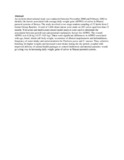| dc.description.abstract | An on-farm observational study was conducted between November 2000 and February 2002 to identify the factors
associated with average daily weight gain (ADWG) of calves in Maasai pastoral systems of Kenya. The study
involved a two-stage random sampling of 23 herds from 2 former Group Ranches. A total of 1,694 observations
were made on 292 calves aged less than 13 months. Univariate and multivariate mixed model analysis were used to
determine the association between growth rate and potential explanatory factors for ADWG. The overall ADWG
was 0.26 kg (-0.57- 0.81 kg). There were significant differences in ADWG associated with age, breed, initial calf
body weight, occurrence of clinical anaplasmosis and helminthiasis, frequency of water intake and seroconversion
for Theilaria parva and T. mutans. Thus, selective breeding for higher weights and increased water intake during the
dry period, coupled with improved delivery of animal health packages to control theileriosis and internal parasites
would go a long way in increasing daily weight gains of calves in Maasai pastoral systems. | en_US |


